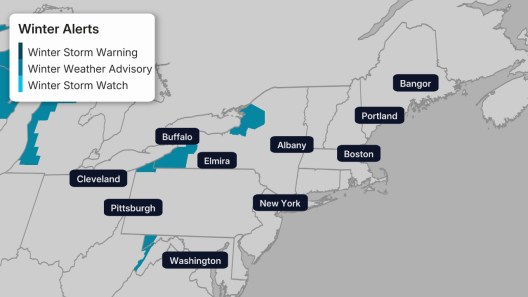The threat of flooding has returned to portions of the South, mid-Mississippi Valley and Ohio Valley this week due to the combination of a slow-moving system and plentiful moisture.
Already, clusters of heavy rain have developed from Texas to southern Ohio as of Wednesday morning.
Heavy rainfall prompted flash flood warnings to be issued in parts of Texas early Wednesday, including the Austin area where more than 4 inches of rain has fallen since midnight in some locations. Several water rescues were reported in the San Antonio area early Wednesday. Additional reports of flooding can be found below the rainfall forecast section.
(MAPS: Weekly Planner)
An upper-level trough, or southward plunge in the jet stream, will gradually move through the Plains midweek. Thanks to this jet-stream feature, a slow-moving front will glide east from the Plains into the Mississippi Valley through Thursday.
Deep moisture from the Gulf of Mexico will surge northward ahead of this slow-moving cold front.

As a result, clusters of heavy rain will continue through at least Thursday in parts of the South, and at times into the mid-Mississippi and lower Ohio valleys.
Flash flooding is a serious concern, especially where training thunderstorms – storms that move over the same region in a short period of time – develop. The heavy rain will create rapid rises on smaller streams and rivers, and eventually trigger rises on mainstem rivers lasting well into next week.
The heaviest rainfall is expected through Thursday from eastern parts of Texas northeastward into Arkansas, Louisiana, Mississippi, Tennessee and Kentucky.

While repeated heavy rainfall will be the biggest concern, there is also the chance for a few severe thunderstorms each day.
(MORE: Tornado Central)
The chance for thunderstorms, including a few that will contain hail and damaging winds, is expected to shift east Wednesday from the Texas Gulf Coast into Louisiana, western Mississippi and southern Arkansas.
Thursday, a few severe storms are possible in the Deep South, from southeast Louisiana to Alabama.
Storms each day will have the threat of damaging wind gusts and large hail.
(MAPS: Local Severe Weather Forecast)
How Much Rainfall?
An additional 2 to 6 inches of rain is anticipated from eastern Texas into Arkansas, Louisiana, Mississippi, Tennessee, Kentucky and southern Ohio. Some areas could potentially see higher amounts where bands of heavy rain stall.

(Locally higher rainfall amounts are possible where bands or clusters of heavy rain stall for a period of a few hours.)
Flood watches have been posted by the National Weather Service from the Texas coast to southern Ohio and West Virginia, including Houston, Dallas, Austin, Shreveport, Little Rock, Memphis, Nashville and Louisville.

(Watches and warnings are issued by the National Weather Service.)
The National Weather Service in Little Rock noted that the chance of flooding is higher in its area compared to late February, when there was a similar setup of heavy rainfall. This higher risk is due to the recent elimination of drought conditions and the increase in ground moisture compared to before the February event.
Prior to the heavy rain in late February, it was dry and the flow on area rivers was low. Fast forward to now, and things have changed. Ground moisture has increased, and minor flooding is ongoing on several rivers. Bottom line: Flooding is more likely than a month ago.#arwx pic.twitter.com/cPvjwWroll
— NWS Little Rock (@NWSLittleRock) March 22, 2018
There is some good news: many locations have been relatively dry over the past two weeks, which has allowed a lot of water to clear out of the region, the Memphis NWS office commented in its Friday discussion.
Even with the recent dry conditions, however, river flooding will be a concern in the week ahead, as well as into the first two weeks of April.
Flooding and Storm Reports So Far
On Monday, flooding washed out a section of railroad track in Marshall, Missouri, and a water rescue was performed near Lake Winnebago, Missouri, when a car was stuck in water up to its door.
Monday was the wettest day at the National Weather Service office in the Kansas City metro since early August, where almost 4 inches of rain fell.
Scattered strong to severe thunderstorms developed along a dryline in portions of northern Texas and southern Oklahoma on Monday. Large hail up to baseball-size was reported in the region.
@newswest9 @NWSMidland This is hail from the storm that went south of Loraine, Mitchell County pic.twitter.com/0KlqT0a0Iq
— Jessica (@jesschambliss) March 27, 2018
On Tuesday, numerous roads in southern Missouri were closed due to flooding.
Not Much Drought Relief
Areas that really need rainfall are not expected to pick up much from this next system.
This includes western Oklahoma, which remains in extreme or exceptional drought, according to the March 20 update of the U.S. Drought Monitor. Just over a third of the state is in the extreme drought category, with about 8 percent in exceptional drought, the highest category.

(U.S. Drought Monitor)
The Texas Panhandle and Kansas are also experiencing drought conditions. Amarillo, Texas, has only received 0.01 inches of precipitation since Oct. 13. The average rainfall there from mid-October to March 21 is about 5 inches.
The discussion from the U.S. Drought Monitor indicated that “the dryness is beginning to affect agriculture, plant and wildlife. It was reported that cotton and corn growers in the Rio Grande Valley may begin to irrigate earlier than normal due to the abnormally dry conditions in the area. According to the USDA, 60 percent of wheat in Texas was in poor to very poor condition while 66 percent of topsoil moisture across the state was short to very short.”
There is a chance for some generally light precipitation in these areas, but the bulk of the moisture will stay to the east.

I just drove from Atlanta to Fort Scott, Kansas, rained the whole damn way. No rain now in Fort Scott.